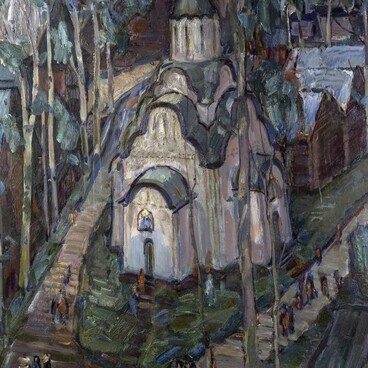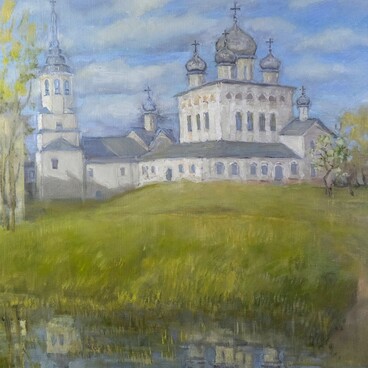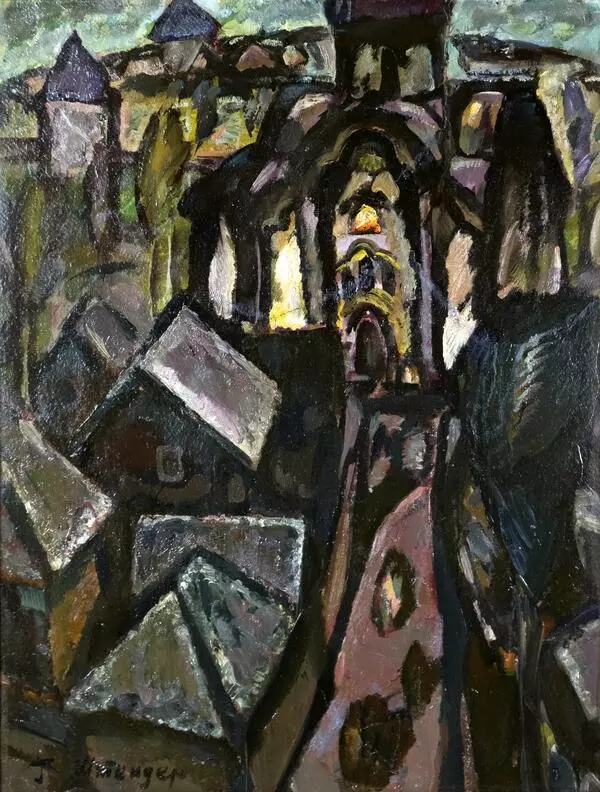Grigory Mikhailovich Shtender, as a professional architect-restorer, could depict ancient Novgorod buildings with academic accuracy. But as an artist, he sought to convey a personal, emotional interpretation of the city and its fate through color and the interweaving of history and legends. He often created generalized images by painting objects that were located in the same territory at the same time. Due to the peculiarities of his style and the artistic idea itself, they can be difficult to decipher.
Among the generalized images, Shtender depicted the monastery complex on Lake Myachino.
Evidently, the artist combined the ensembles of two monasteries in the canvas: the Annunciation Monastery on Lake Myachino and the Assumption Monastery near the village of Arkazhy. Their territorial proximity was the cause of some confusion and misunderstandings among researchers.
In the mid-19th century, the Assumption Monastery was examined by researchers. During the exploration, the Annunciation Church also began to be called the church “in Arkazhy” after a nearby large village, a former sloboda (a settlement freed from taxes and levies) that grew near the Assumption Monastery and was abandoned during the Great Patriotic War. As a result, the stories of the two monasteries intertwined into one.
The Annunciation Monastery was founded by Archbishop Elijah and his brother Gabriel, the wooden church of the Annunciation was then erected as well. In 1179, a new stone Annunciation Cathedral was laid. It only took 70 days to build it.
Apart from it, one can recognize in the painting the Church of the Resurrection of Christ (or of the Incredulity of Thomas) and the Church of St. John the Almsgiver, Patriarch of Alexandria. Both of them once belonged to the Resurrection Convent. Archimandrite Ambrose (Ornatsky) and Archimandrite Makarii wrote about this monastery in their works. It is not known exactly when it was built: the first mention in the Novgorod First Chronicle of 1136 already reports that it was damaged in a fire. However, it is established that the first wooden Resurrection Church was erected in 1196 and replaced with a stone one in 1464. The Church of St. John the Almsgiver was built in 1421–1423.
Like many monasteries, the Resurrection Monastery was ravaged by the Swedes in 1611–1617, the monastic cells and the fence were burned down. For fifteen years the monastery was deserted, then it was restored, but in the first half of the 18th century it fell into decline again and was abolished in 1743. The Church of the Resurrection remained and received the status of a parish.
By the early 1960s, the monastery buildings that had survived the Great Patriotic War were in disrepair. The two remaining churches were restored: the project was developed by of Leonid Yegorovich Krasnorechyev.
Among the generalized images, Shtender depicted the monastery complex on Lake Myachino.
Evidently, the artist combined the ensembles of two monasteries in the canvas: the Annunciation Monastery on Lake Myachino and the Assumption Monastery near the village of Arkazhy. Their territorial proximity was the cause of some confusion and misunderstandings among researchers.
In the mid-19th century, the Assumption Monastery was examined by researchers. During the exploration, the Annunciation Church also began to be called the church “in Arkazhy” after a nearby large village, a former sloboda (a settlement freed from taxes and levies) that grew near the Assumption Monastery and was abandoned during the Great Patriotic War. As a result, the stories of the two monasteries intertwined into one.
The Annunciation Monastery was founded by Archbishop Elijah and his brother Gabriel, the wooden church of the Annunciation was then erected as well. In 1179, a new stone Annunciation Cathedral was laid. It only took 70 days to build it.
Apart from it, one can recognize in the painting the Church of the Resurrection of Christ (or of the Incredulity of Thomas) and the Church of St. John the Almsgiver, Patriarch of Alexandria. Both of them once belonged to the Resurrection Convent. Archimandrite Ambrose (Ornatsky) and Archimandrite Makarii wrote about this monastery in their works. It is not known exactly when it was built: the first mention in the Novgorod First Chronicle of 1136 already reports that it was damaged in a fire. However, it is established that the first wooden Resurrection Church was erected in 1196 and replaced with a stone one in 1464. The Church of St. John the Almsgiver was built in 1421–1423.
Like many monasteries, the Resurrection Monastery was ravaged by the Swedes in 1611–1617, the monastic cells and the fence were burned down. For fifteen years the monastery was deserted, then it was restored, but in the first half of the 18th century it fell into decline again and was abolished in 1743. The Church of the Resurrection remained and received the status of a parish.
By the early 1960s, the monastery buildings that had survived the Great Patriotic War were in disrepair. The two remaining churches were restored: the project was developed by of Leonid Yegorovich Krasnorechyev.





